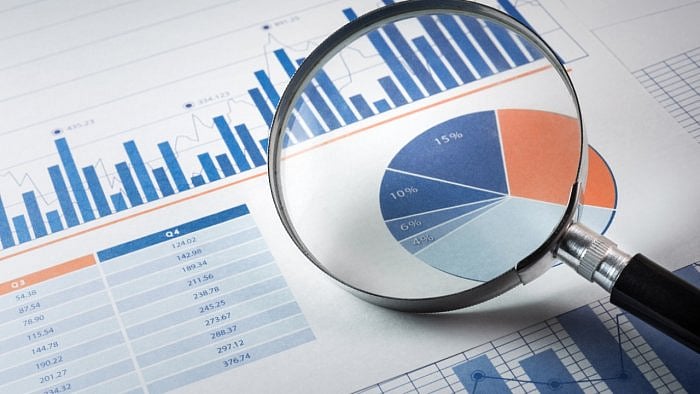
India's Economic Survey, presented ahead of the Union Budget for the fiscal year 2021-22, forecast a "V-shaped" economic recovery, emphasising the government's policy response to the Covid-19 pandemic. Finance Minister Nirmala Sitharaman tabled the Economic Survey in the Parliament and CEA Krishnamurthy Subramanian later spelt out the points noted in the Survey.
Here are the key takeaways from the Economic Survey 2021-22:
* The estimated real GDP growth for FY22 at 11 per cent is the highest since Independence.
* Global economic output is estimated to fall by 4.4 per cent in 2020, the sharpest contraction in a century. Advanced economies were hit harder, in terms of lives and economic output, compared to Emerging Market Developing Economies.
* Overall, India is expected to witness current account surplus during the current financial year after a gap of 17 years.
* The foreign exchange reserves rose to an all-time high of US $586.1 billion as on January 8, 2021.
* India’s GDP is estimated to contract 7.7 per cent in FY21, composed of a sharp 15.7 per cent decline in H1FY21 and a modest 0.1 per cent fall in the second half of FY21.
* Agriculture sector has remained the silver lining while contact-based services, manufacturing, construction were hit the hardest. Starting July, a resilient V-shaped recovery is well underway, as demonstrated by the recovery in GDP growth and the sustained resurgence in high-frequency indicators such as power demand, E-way bills, GST collection, steel consumption, etc.
* Inflation, mainly driven by food prices, remained above 6 per cent for much of the year, given supply disruptions. The softening of CPI inflation recently reflects the easing of supply-side constraints that affected food inflation.
* Owing to the recovery of the economy over the past few months, the monthly revenue collections have witnessed an uptick. The monthly GST collections have crossed the Rs 1 lakh crore mark consecutively for the last 3 months, reaching its highest ever in December 2020.
* Trade balance with China and the US improved as imports slowed.
* While exports of gems and jewellery, engineering goods, textile and allied products slide, exports of drugs and pharma, software and agriculture and allied products improved. Pharma exports, in particular, hold the potential to be the pharmacy of the world.
* While the lockdown resulted in a 23.9 per cent contraction in GDP in Q1, the recovery has been a V-shaped one as seen in the 7.5 per cent decline in Q2 and the recovery across all key economic indicators.
* The Survey notes that an increase in public spending on the healthcare from 1 per cent to 2.5-3 per cent of GDP – as envisaged in the National Health Policy 2017 – can decrease the out-of-pocket expenses from 65 per cent to 30 per cent of overall healthcare spend.
* A public investment programme centred around the National Infrastructure Pipeline is likely to accelerate the demand push and further the recovery.
* It suggests that telemedicine needs to be harnessed to the fullest by investing in internet connectivity and health infrastructure.
* India entered the top 50 innovating countries for the first time in 2020 since the inception of the Global Innovation Index in 2007, by improving its rank from 81 in 2015 to 48 in 2020. India ranks first in Central and South Asia, and third amongst lower-middle-income group economies.
* A sectoral regulator to undertake regulation and supervision of the healthcare sector must be considered given the market failures stemming from information asymmetry; WHO also highlights the growing importance of the same.
* Given India’s stage of development, India must continue to focus on economic growth to lift the poor out of poverty by expanding the overall pie.
* The National Health Mission (NHM) has played a critical role in mitigating inequity as the access of the poorest to pre-natal and post-natal care as well as institutional deliveries has increased significantly. Therefore, in conjunction with Ayushman Bharat, the emphasis on NHM should continue.
* The legal infrastructure for the recovery of loans needs to be strengthened de facto.
* Indian residents’ share in total patents filed in the country stands at 36 per cent. This lags behind the average of 62 per cent in other largest economies. Resident share in patent applications must rise for India to become an innovative nation
* India must focus on improving its performance on institutions and business sophistication innovation inputs. These are expected to result in higher improvement in innovation output.
* For India to become an innovation leader, it needs greater thrust on innovation. India’s aspiration must be to compete on innovation with the top ten economies. India’s gross domestic expenditure on R&D (GERD) is lowest amongst other largest economies. India’s business sector needs to significantly ramp up investments in R&D.
* PM-JAY is being used significantly for high frequency, low-cost care such as dialysis and continued to be utilised without disruption even during the Covid pandemic and the lockdown. General medicine exhibited a V-shaped recovery after falling during the lockdown and reached pre-Covid-19 levels in December 2020.
* PM-JAY enhanced health insurance coverage. The proportion of households that had health insurance increased in Bihar, Assam and Sikkim from 2015-16 to 2019-20 by 89 per cent while it decreased by 12 per cent over the same period in West Bengal.
* Never in the history of sovereign credit ratings has the fifth-largest economy in the world been rated as the lowest rung of the investment-grade (BBB-/Baa3). Reflecting the economic size and thereby the ability to repay debt, the fifth-largest economy has been predominantly rated AAA. China and India are the only exceptions to this rule – China was rated A-/A2 in 2005 and now India is rated BBB-/Baa3.
